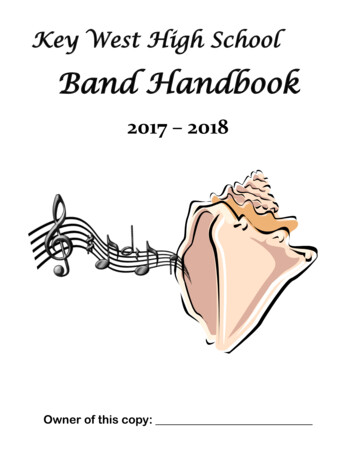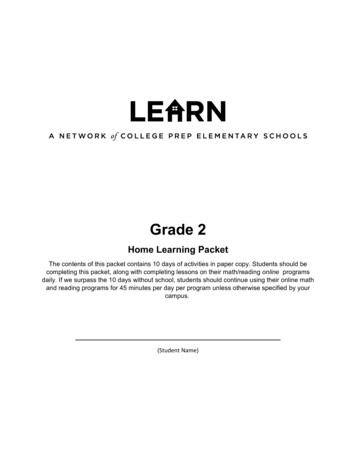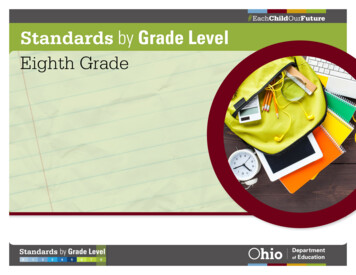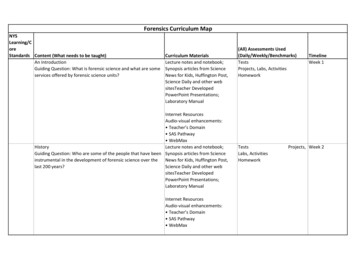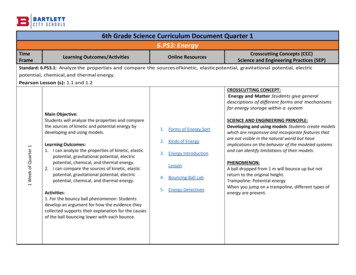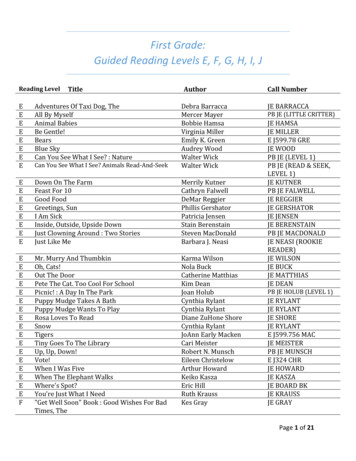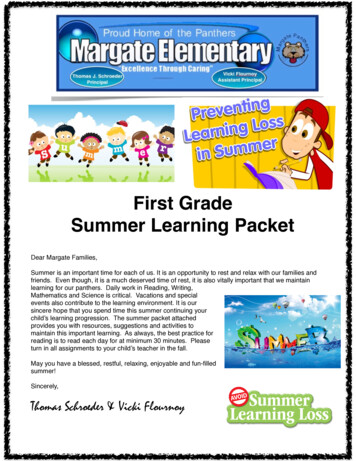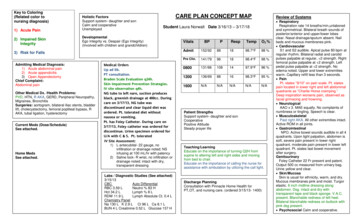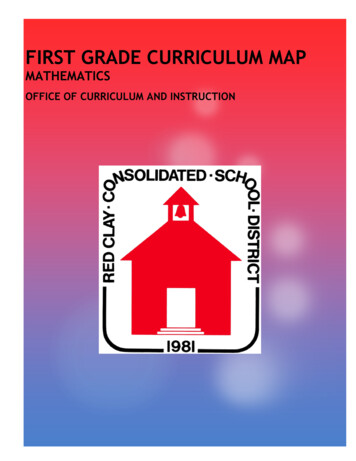
Transcription
FIRST GRADE CURRICULUM MAPMATHEMATICSOFFICE OF CURRICULUM AND INSTRUCTION
First Grade Curriculum MapTo:First Grade TeachersFrom:Jodi AlbersDate:July 19, 2017Re:First Grade Math Expressions Curriculum MapMathematicsDear Teachers,This is a draft of the Math Expressions curriculum map that correlates the Common Core State Standards inMathematics. Please note: this is a draft. Your suggestions and feedback should be given to your Math ExpressionsLead Teacher so appropriate changes can be made.This document is divided into the following sections: Instructional Focus Mathematical Practices Scope and Sequence Curriculum MapInstructional FocusThis summary provides a brief description of the critical areas of focus, required fluency for the grade level, majoremphasis clusters, and examples of major within-grade dependencies.The Common Core State Standards for Mathematics begin each grade level from kindergarten through eighth gradewith a narrative explaining the Critical Areas for that grade level. The Critical Areas are designed to bring focus tothe standards by outlining the essential mathematical ideas for each grade level.Mathematical PracticesThe Common Core State Standards for Mathematics define what students should understand and be able to do in theirstudy of mathematics. The Standards for Mathematical Practice describe varieties of expertise that mathematicseducators at all levels should seek to develop in their students. The Standards for Mathematical Practice areincluded first in this document because of their importance and influence in teaching practice.Scope and SequenceThis table provides the unit sequence and pacing for Math Expressions.Curriculum Map – By UnitThe curriculum map provides the alignment of the grade level Math Expressions units with state-adopted standards aswell as unit specific key elements such as learning progressions, essential questions learning targets, andAssessments.A special thank you to the First Grade Math Expressions Lead Teachers who created these documents for the Red ClayConsolidated School District.Sincerely,Jodi AlbersRed Clay Consolidated School DistrictDepartment of Curriculum and Instruction(302) 552-3820jodi.albers@redclay.k12.de.usUpdated Summer 2017
First Grade Curriculum MapMathematics2017 – 2018 Math Expressions Lead TeachersKindergarten TeamMichelle Finegan, Richardson Park Learning CenterJackie Gallagher, Highlands Elementary SchoolChristine Saggese, Cooke Elementary SchoolBeth Ann Turner, Forest Oak Elementary SchoolFirst Grade TeamSamantha Ches, Shortlidge AcademySara Edler, Marbrook Elementary SchoolBrandy Wilkins, Lewis Dual Language Elementary SchoolSecond Grade TeamGabriele Adiarte, Mote Elementary SchoolSherri Brooks, Richey Elementary SchoolStephanie Fleetwood, Linden Hill Elementary SchoolThird Grade TeamSarah Bloom, Brandywine Springs Elementary SchoolKaren Cooper, North Star Elementary SchoolKathleen Gormley, Highlands Elementary SchoolKathryn Hudson, Cooke Elementary SchoolAmy Starke, Heritage Elementary SchoolFourth Grade TeamAmber Tos, Baltz Elementary SchoolFifth Grade TeamJennifer Greevy, Forest Oak Elementary SchoolErin McGinnley, Warner Elementary SchoolStacie Zdrojewski, Richey Elementary SchoolUpdated Summer 2017
First Grade Curriculum MapMathematicsInstructional FocusIn Grade 1, instructional time should focus on four critical areas: (1) developing understanding of addition,subtraction, and strategies for addition and subtraction within 20; (2) developing understanding of whole numberrelationships and place value, including grouping in tens and ones; (3) developing understanding of linearmeasurement and measuring lengths as iterating length units; and (4) reasoning about attributes of, and composingand decomposing geometric shapes.1. Students develop strategies for adding and subtracting whole numbers based on their prior work with smallnumbers. They use a variety of models, including discrete objects and length-based models (e.g., cubesconnected to form lengths), to model add-to, take-from, put-together, take-apart, and compare situations todevelop meaning for the operations of addition and subtraction, and to develop strategies to solve arithmeticproblems with these operations. Students understand connections between counting and addition and subtraction(e.g., adding two is the same as counting on two). They use properties of addition to add whole numbers and tocreate and use increasingly sophisticated strategies based on these properties (e.g., “making tens”) to solveaddition and subtraction problems within 20. By comparing a variety of solution strategies, children build theirunderstanding of the relationship between addition and subtraction.2. Students develop, discuss, and use efficient, accurate, and generalizable methods to add within 100 and subtractmultiples of 10. They compare whole numbers (at least to 100) to develop understanding of and solve problemsinvolving their relative sizes. They think of whole numbers between 10 and 100 in terms of tens and ones(especially recognizing the numbers 11 to 19 as composed of a ten and some ones). Through activities that buildnumber sense, they understand the order of the counting numbers and their relative magnitudes.3. Students develop an understanding of the meaning and processes of measurement, including underlying conceptssuch as iterating (the mental activity of building up the length of an object with equal-sized units) and thetransitivity principle for indirect measurement.14. Students compose and decompose plane or solid figures (e.g., put two triangles together to make a quadrilateral)and build understanding of part-whole relationships as well as the properties of the original and compositeshapes. As they combine shapes, they recognize them from different perspectives and orientations, describe theirgeometric attributes, and determine how they are alike and different, to develop the background formeasurement and for initial understandings of properties such as congruence and symmetry.Key Areas of Focus for K-2:Addition and subtraction—concepts, skills, and problem solvingRequired Fluency:1.OA .6 Add and subtract within 10.1 Students should apply the principle of transitivity of measurement to make indirect comparisons, but they need not use thistechnical term.Updated Summer 2017
First Grade Curriculum MapMathematicsMajor Emphasis Clusters:Operations and Algebraic Thinking Represent and solve problems involving addition and subtraction. Understand and apply properties of operations and the relationship between addition andsubtraction. Add and subtract within 20. Work with addition and subtraction equations.Number and Operations in Base Ten Extend the counting sequence. Understand place value. Use place value understanding and properties of operations to add and subtract.Measurement and Data Measure lengths indirectly and by iterating length unitsUpdated Summer 2017
First Grade Curriculum MapMathematicsStandards for Mathematical PracticesThe Standards for Mathematical Practice describe varieties of expertise that mathematics educators at all levelsshould seek to develop in their students. These practices rest on important “processes and proficiencies” withlongstanding importance in mathematics education. The first of these are the NCTM process standards of problemsolving, reasoning and proof, communication, representation, and connections. The second are the strands ofmathematical proficiency specified in the National Research Council’s report Adding It Up: adaptive reasoning,strategic competence, conceptual understanding (comprehension of mathematical concepts, operations andrelations), procedural fluency (skill in carrying out procedures flexibly, accurately, efficiently and appropriately), andproductive disposition (habitual inclination to see mathematics as sensible, useful, and worthwhile, coupled with abelief in diligence and one’s own efficacy).Connecting the Standards for Mathematical Practice to the Standards for MathematicalContentThe Standards for Mathematical Practice describe ways in which developing student practitioners of the discipline ofmathematics increasingly ought to engage with the subject matter as they grow in mathematical maturity andexpertise throughout the elementary, middle and high school years. Designers of curricula, assessments, andprofessional development should all attend to the need to connect the mathematical practices to mathematicalcontent in mathematics instruction. The Standards for Mathematical Content are a balanced combination ofprocedure and understanding. Expectations that begin with the word “understand” are often especially goodopportunities to connect the practices to the content. Students who lack understanding of a topic may rely onprocedures too heavily. Without a flexible base from which to work, they may be less likely to consider analogousproblems, represent problems coherently, justify conclusions, apply the mathematics to practical situations, usetechnology mindfully to work with the mathematics, explain the mathematics accurately to other students, step backfor an overview, or deviate from a known procedure to find a shortcut. In short, a lack of understanding effectivelyprevents a student from engaging in the mathematical practices. In this respect, those content standards which setan expectation of understanding are potential “points of intersection” between the Standards for MathematicalContent and the Standards for Mathematical Practice. These points of intersection are intended to be weightedtoward central and generative concepts in the school mathematics curriculum that most merit the time, resources,innovative energies, and focus necessary to qualitatively improve the curriculum, instruction, assessment,professional development, and student achievement in mathematics.Standards for Mathematical Practice1. Make sense of problems and persevere in solving themMathematically proficient students start by explaining to themselves the meaning of a problem and looking forentry points to its solution. They analyze givens, constraints, relationships, and goals. They make conjecturesabout the form and meaning of the solution and plan a solution pathway rather than simply jumping into asolution attempt. They consider analogous problems, and try special cases and simpler forms of the originalproblem in order to gain insight into its solution. They monitor and evaluate their progress and change course ifnecessary. Older students might, depending on the context of the problem, transform algebraic expressions orchange the viewing window on their graphing calculator to get the information they need. Mathematicallyproficient students can explain correspondences between equations, verbal descriptions, tables, and graphs ordraw diagrams of important features and relationships, graph data, and search for regularity or trends. Youngerstudents might rely on using concrete objects or pictures to help conceptualize and solve a problem.Mathematically proficient students check their answers to problems using a different method, and theycontinually ask themselves, “Does this make sense?” They can understand the approaches of others to solvingcomplex problems and identify correspondences between different approaches.Updated Summer 2017
First Grade Curriculum MapMathematics2. Reason abstractly and quantitativelyMathematically proficient students make sense of quantities and their relationships in problem situations. Theybring two complementary abilities to bear on problems involving quantitative relationships: the ability todecontextualize—to abstract a given situation and represent it symbolically and manipulate the representingsymbols as if they have a life of their own, without necessarily attending to their referents—and the ability tocontextualize, to pause as needed during the manipulation process in order to probe into the referents for thesymbols involved. Quantitative reasoning entails habits of creating a coherent representation of the problem athand; considering the units involved; attending to the meaning of quantities, not just how to compute them; andknowing and flexibly using different properties of operations and objects.3. Construct viable arguments and critique the reasoning of others.Mathematically proficient students understand and use stated assumptions, definitions, and previouslyestablished results in constructing arguments. They make conjectures and build a logical progression ofstatements to explore the truth of their conjectures. They are able to analyze situations by breaking them intocases, and can recognize and use counterexamples. They justify their conclusions, communicate them to others,and respond to the arguments of others. They reason inductively about data, making plausible arguments thattake into account the context from which the data arose. Mathematically proficient students are also able tocompare the effectiveness of two plausible arguments, distinguish correct logic or reasoning from that which isflawed, and—if there is a flaw in an argument—explain what it is. Elementary students can construct argumentsusing concrete referents such as objects, drawings, diagrams, and actions. Such arguments can make sense andbe correct, even though they are not generalized or made formal until later grades. Later, students learn todetermine domains to which an argument applies. Students at all grades can listen or read the arguments ofothers, decide whether they make sense, and ask useful questions to clarify or improve the arguments.4. Model with mathematicsMathematically proficient students can apply the mathematics they know to solve problems arising in everydaylife, society, and the workplace. In early grades, this might be as simple as writing an addition equation todescribe a situation. In middle grades, a student might apply proportional reasoning to plan a school event oranalyze a problem in the community
19.07.2017 · A special thank you to the First Grade Math Expressions Lead Teachers who created these documents for the Red Clay Consolidated School District. Sincerely, Jodi Albers Red Clay Consolidated School District Department of Curriculum and Instruction (302) 552-3820 jodi.albers@redclay.k12.de.us . First Grade Curriculum Map Mathematics Updated Summer 2017 2017 – 2018 Math Expressions Lead .File Size: 1MBPage Count: 29
